|
|
|
|
|
|
| Sir Thomas Browne (1605-1682) He was born in
London and educated at Winchester and Pembroke College, Oxford.
After a tour of Ireland he studied medicine at
Montpellier and Padua. He settled in Norwich in about
1637 - after he had already written Religio
Medico. In 1671, he was knighted by Charles II when
the King visited Norwich. Browne's other well known works include: Pseudodoxia Epidemica
(Vulgar Errors), Hydriotaphia, Urne Burial
and The Garden of Cyrus or The Quincuncial.
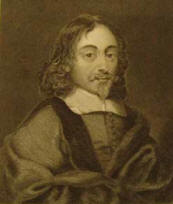
Portrait of Sir Thomas Browne
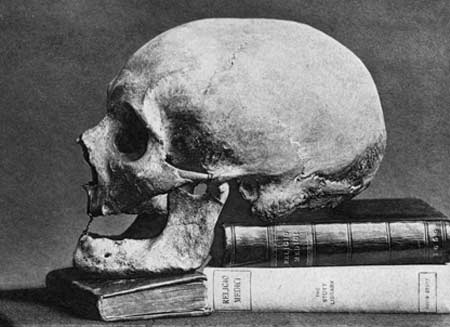
Sir Thomas Browne's Skull He lived in
a house which stood at the junction of Orford Yard
and the Haymarket. The house was demolished in 1842 -
but there is a commemorative plaque on the wall to mark
the site. A mantle piece from the house is held by the
Norwich Castle Museum.
In addition to being a medical doctor, Browne
was also a keen naturalist and delighted in collecting
curiosities - which included, at one time, a live
bittern and a stuffed dolphin. He was visited in his house by the diarist John
Evelyn on 18th October, 1671 who described it thus:
|
|
'Next morning I went to see Sir Thomas Browne (with whom
I had sometime corresponded by letters tho never saw
before) whose whole house & garden being a paradise and
cabinet of rarites, & that of the best collection,
especialy medails, book, plants, natural things, did
exceedingly refresh me after last nights confusion: Sir
Thomas had amongst other curiosities,a collection of the
eggs of all foul and birds he could procure, that
country (especialy the promontorys of Norfolck) being
(as he said) frequented with the severall kinds, which
seldome or never, go farther into the land, as cranes,
storkes, eagles etc. and a variety of water-foule.' |
In the
following paragraph from Notes on the Natural History
of Norfolk Browne describes a strange bird that
was brought to him:
|
|
'A kind of stork was shott in the wing by the sea neare
Hasburrowe and brought alive unto mee; it was about a
yard high, red head, colourd leggs, and bill, the clawes
resembling human nayles, such as Herodotus describeth in
the white Ibis of AEgypt.' |
Browne was also the first person to document the
Norfolk dialect. In
his tract entitled: Of Languages and Particularly of
the Saxon Tongue he identified words such as 'mawther'
(meaning woman or girl), 'stingy' (meaning mean) and
'bunny' (meaning bruise or swelling). Some of the words
he identified, however, had become obsolete by the time
the Rev Robert Forby (see Fincham)
wrote his famous Vocabulary of East Anglia
(1830).Browne is buried
in the chancel of St.
Peter Mancroft Church which stands close by. In 1840 Browne's coffin was
accidentally opened and his skull was removed. It was
presented to the Museum of the
Norfolk and Norwich Hospital - where it remained until
1922 when, after a number of casts were taken, it was
returned to his grave in St. Peter Mancroft. Ironically,
Browne wrote: 'to be gnawed out of our graves, to have
our skulls made drinking bowls and our bones turned into
pipes
is a Tragical abomination'. Little did he know that this
would be his own fate.
Samuel Johnson wrote a biography of Browne which
was published in 1756.
In The Rings of
Saturn W.G.Sebald meditates at length upon Browne's
life and work and also includes photographs of Browne's
skull and of his famous 'Quincunx' pattern.
In 1905 a statue to Browne was erected on Hay Hill to mark
the tercentenary of his birth.
The sculpture captures Browne contemplating a broken
burial urn - an artefact which would have inspired his
Hydriotaphia (see Great Walsingham).
Norwich City Council has recently commissioned the artists Anne and Patrick
Poirier to produce a 'Homage to Thomas
Browne' - which features a marble eye and brain and
various seats and benches which have been located in front of
his
statue. Browne's statue also crops up in the The
Go-Between by L.P. Hartley - because it is here that
Leo Colston waits for Marian on their shopping trip to
Norwich.
|
|
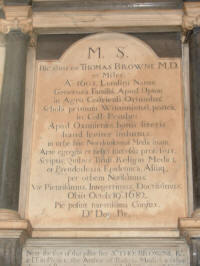 |
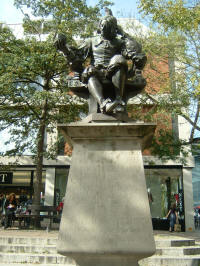 |
|
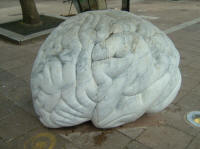 |
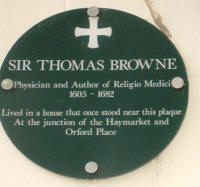 |
See also Great Walsingham
and Felbrigg.
|
|
|
|

